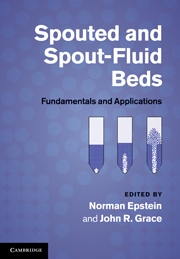Book contents
- Frontmatter
- Contents
- Contributors
- Preface
- Common nomenclature
- 1 Introduction
- 2 Initiation of spouting
- 3 Empirical and analytical hydrodynamics
- 4 Computational fluid dynamic modeling of spouted beds
- 5 Conical spouted beds
- 6 Hydrodynamics of spout-fluid beds
- 7 Spouted and spout-fluid beds with draft tubes
- 8 Particle mixing and segregation
- 9 Heat and mass transfer
- 10 Powder–particle spouted beds
- 11 Drying of particulate solids
- 12 Drying of solutions, slurries, and pastes
- 13 Granulation and particle coating
- 14 The Wurster coater
- 15 Gasification, pyrolysis, and combustion
- 16 Spouted bed electrochemical reactors
- 17 Scaleup, slot-rectangular, and multiple spouting
- 18 Mechanical spouting
- 19 Catalytic reactors and their modeling
- 20 Liquid and liquid–gas spouting of solids
- Index
- References
2 - Initiation of spouting
Published online by Cambridge University Press: 04 February 2011
- Frontmatter
- Contents
- Contributors
- Preface
- Common nomenclature
- 1 Introduction
- 2 Initiation of spouting
- 3 Empirical and analytical hydrodynamics
- 4 Computational fluid dynamic modeling of spouted beds
- 5 Conical spouted beds
- 6 Hydrodynamics of spout-fluid beds
- 7 Spouted and spout-fluid beds with draft tubes
- 8 Particle mixing and segregation
- 9 Heat and mass transfer
- 10 Powder–particle spouted beds
- 11 Drying of particulate solids
- 12 Drying of solutions, slurries, and pastes
- 13 Granulation and particle coating
- 14 The Wurster coater
- 15 Gasification, pyrolysis, and combustion
- 16 Spouted bed electrochemical reactors
- 17 Scaleup, slot-rectangular, and multiple spouting
- 18 Mechanical spouting
- 19 Catalytic reactors and their modeling
- 20 Liquid and liquid–gas spouting of solids
- Index
- References
Summary
Introduction
In a bed packed with particles, the introduction of an upward-flowing fluid stream into the column through a nozzle or opening in a flat or conical base creates a drag force and a buoyancy force on the particles. A cavity forms when the fluid velocity is high enough to push particles aside from the opening, as illustrated in Figure 2.1(a). A permanent and stable vertical jet is established if the nozzle-to-particle-diameter ratio is less than 25 to 30. Further increase in fluid flow rate expands the jet, and an “internal spout” is established, as in Figure 2.1(b). Eventually, the internal spout breaks through the upper bed surface, leading to the formation of an external spout or fountain, as in Figure 2.1(c). Such an evolution process to a spouted bed, involving cavity formation, internal spout/jet expansion, and formation of an external spout, was well documented in the 1960s.
Figure 2.2 shows the evolution of measured total pressure drop in a half-circular conical bed for 1.16-mm-diameter glass beads and ambient air, starting with a loosely packed bed, Run 1. It is seen that the total pressure drop increases with increasing gas velocity in the gas flow ascending process (shown by closed squares), and reaches a peak value before decreasing to approximately a constant value with a further increase in the gas velocity.
- Type
- Chapter
- Information
- Spouted and Spout-Fluid BedsFundamentals and Applications, pp. 17 - 28Publisher: Cambridge University PressPrint publication year: 2010



